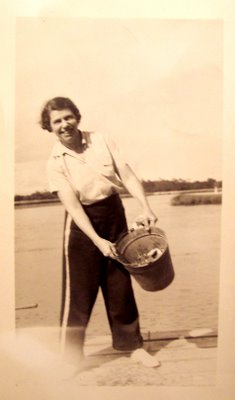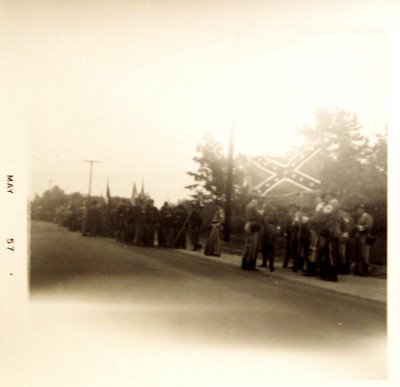"i found your photo" - Featured in Washington City Paper
Found Photograph
I would like to thank Hetty for driving all the way out to Reston to see this show. Hetty, our conversation about photography is a memory I'll always treasure. I'm also deeply appreciative of the editors of Washington City Paper for the wonderful opportunity to have this important project featured in their publication. And I'd also like to thank Washington City Paper's staff photographer, Darrow Montgomery, for treking out to the wild west suburbs of Reston to shoot my photo. Darrow, I'm extremely jealous of your Leicas, man!
James W. Bailey
Artifacts
From the January 13, 2006 issue, page 46.
Shutter to Think
By Hetty Lipscomb
Wearing a tight skirt, a tough, light-haired girl squats in the dirt, aiming a shotgun into the distance. Is she hunting rabbits? Firing after a boyfriend who done her wrong? We’ll probably never know: The image is a small black-and-white snapshot featured in “I Found Your Photo,” an exhibition of found photos currently on view in Reston at the University of Phoenix, Northern Virginia Campus. Curated by Reston artist James W. Bailey, 44, the exhibition features some 30-plus photographs, ranging from a turn-of-the-century portrait of a young woman in a plumed hat to a color Polaroid of a cat sunning itself in a window. The show’s aim is to uphold these random discoveries as fine-art objects, worthy of viewers’ attention and speculation.
While a number of the found photographs are donations, many are drawn from Bailey’s own archive. With a dash of Southern romanticism, Bailey describes found photographs as “mythological.” “Usually there’s no written record with them,” he says. “It’s easy to look at them and construct a history. Just let your imagination run wild.” Consider the unintended pairing of two photographs in the exhibit: One shows a statue of the Madonna bound to the interior of a moving van; the other, a dark-haired bride who, with her high veil, evokes the majesty of a devotional object.
Aside from fueling viewers’ imaginations, “I Found Your Photo” serves as a social-outreach project. “I’m very much into the concept of what’s called ‘littoral art,’” says Bailey. “Trying to develop art projects that address social issues.” When the exhibition closes, the pieces will be compiled into an archival book crafted by Reston photographer and book artist Melanie De Cola. The collection will be auctioned on eBay in spring 2006, says Bailey, and the proceeds will supplement the League of Reston Artists’ photography scholarship, awarded annually to a District public-high-school senior slated to attend an accredited arts program or fine-arts college.
The installation is enough to make an archivist wince. Contemporary color photographs, as well as sepia-toned portraits, have been pressed onto sticky cardboard pages and covered with plastic, typical of photo albums available at CVS. “What we were hoping to illustrate is the temporary nature of the photographs,” argues Bailey. He considered displaying the photos in “typical fine-art fashion,” but because most of the pictures were likely once part of family photo albums, he reasons, “they ought to be displayed in an environment that was probably part of their original context.”
For all the artspeak, the decision could have come from Bailey’s heart as much as his head. “Both of my grandmothers had huge collections of family photographs,” he remembers. “As a child, what drove a strong interest in photography was just spending endless hours going through photographs and having my grandmothers telling me history and stories behind them.”
Of course, that experience is hardly unusual—but then neither are many of Bailey’s found photos. When the collection is eventually sold, he will particularly miss the picture from the ’50s or ’60s of a woman resting on the National Mall with the Washington Monument behind her. “It may just be a tourist snapshot,” he says. “Those photographs are taken a million times a day, but it just really captures for me the essence of Washington, D.C.”
—Hetty Lipscomb



